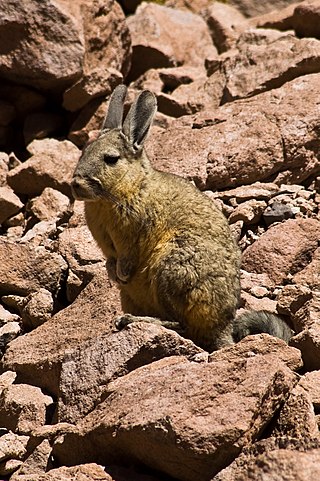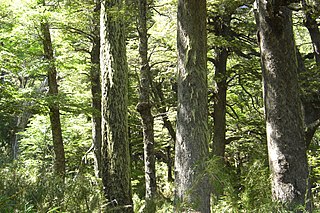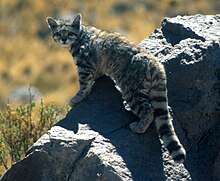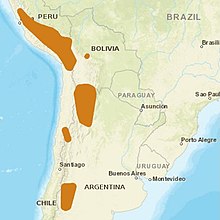
The ocelot is a medium-sized spotted wild cat that reaches 40–50 cm (15.7–19.7 in) at the shoulders and weighs between 7 and 15.5 kg on average. It is native to the southwestern United States, Mexico, Central and South America, and the Caribbean islands of Trinidad and Margarita. Carl Linnaeus scientifically described it in 1758. Two subspecies are recognized.

The oncilla, also known as the northern tiger cat, little spotted cat, and tigrillo, is a small spotted cat ranging from Central America to central Brazil. It is listed as Vulnerable on the IUCN Red List, and the population is threatened by deforestation and conversion of habitat to agricultural land.

Viscacha or vizcacha are rare rodents of two genera in the family Chinchillidae. They are native to South America and convergently resemble rabbits.

The family Caenolestidae contains the seven surviving species of shrew opossum: small, shrew-like marsupials that are confined to the Andes mountains of South America. The order is thought to have diverged from the ancestral marsupial line very early. They were once included in the superorder but it is now known that Ameridelphia is paraphyletic, having given rise to Australidelphia, and thus could be considered an evolutionary grade. Genetic studies indicate that they are the second most basal order of marsupials, after the didelphimorphs. As recently as 20 million years ago, at least seven genera were in South America. Today, just three genera remain. They live in inaccessible forest and grassland regions of the High Andes.

Geoffroy's cat is a small wild cat native to the southern and central regions of South America. It is about the size of a domestic cat. It is listed as Least Concern on the IUCN Red List because it is widespread and abundant over most of its range.

The Pampas fox, also known as grey pampean fox, Pampas zorro, Azara's fox, or Azara's zorro, is a medium-sized zorro, or "false" fox, native to the South American Pampas. Azara in some of its alternative common names is a reference to Spanish naturalist Félix de Azara.

Aconquija National Park, formerly known as Campo de los Alisos National Park, is a federal protected area in Tucumán Province, Argentina. Established on 9 August 1995, it houses a representative sample of the Southern Andean Yungas montane forest biodiversity in good state of conservation.

Leopardus is a genus comprising eight species of small cats native to the Americas. This genus is considered the oldest branch of a genetic lineage of small cats in the Americas whose common ancestor crossed the Bering land bridge from Asia to North America in the late Miocene.

The Reserva Provincial La Payunia also known as Payún or Payén is a natural reserve located in the Malargüe Department in the southern part of Mendoza Province, Argentina, about 160 km away from Malargüe city. It was declared as nature preserve in 1988 and has an area of 4,500 km2. La Payunia is home to the many volcanic cones, being noteworthy the Payún Matrú volcano.

The Pampas cat is a small wild cat native to South America. It is listed as Near Threatened on the IUCN Red List as habitat conversion and destruction may cause the population to decline in the future.
The Pantanal cat is a Pampas cat subspecies, a small wild cat native to South America. It is named after the Pantanal wetlands in central South America, where it inhabits mainly grassland, shrubland, savannas and deciduous forests.

The northern viscacha is a species of viscacha, a rodent in the family Chinchillidae. It is known from Peru and Chile, at elevations from 300 to 5000 m, and may also be present in Bolivia.

Lagidium is a genus of rodents in the family Chinchillidae.

The southern viscacha is a species of viscacha, a rodent in the family Chinchillidae found in Argentina, Bolivia, Chile, and Peru. It is a colonial animal living in small groups in rocky mountain areas. It has long ears and hind legs and resembles a rabbit in appearance apart from its long, bushy tail, but is not a lagomorph.

The Andean Cat Alliance is a network of researchers and conservationists working to study and protect the Andean cat and its habitat in Argentina, Bolivia, Chile and Peru. It is partnered with the Wildlife Conservation Network, and has developed a strategic plan for conservation of the species.

Bosque Andino Patagónico, also known as Patagonian Andean forest, is a type of temperate to cold forest located in western Patagonia in Argentina and also in southern Chile, at the southern end of South America. The climate here is influenced by humid air masses moving in from the Pacific Ocean which lose most of their moisture as they rise over the Andes. The flora is dominated by trees, usually of the genus Nothofagus.

The South American cougar, also known as the Andean mountain lion or puma, is a cougar subspecies occurring in northern and western South America, from Colombia and Venezuela to Peru, Bolivia, Argentina and Chile.


















